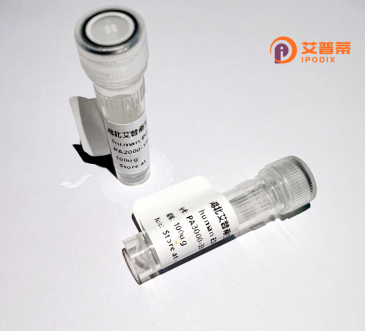
| 纯度 | >90%SDS-PAGE. |
| 种属 | Human |
| 靶点 | BPIL3 |
| Uniprot No | Q8NFQ5 |
| 内毒素 | < 0.01EU/μg |
| 表达宿主 | E.coli |
| 表达区间 | 1-453aa |
| 氨基酸序列 | MLRILCLALCSLLTGTRADPGALLRLGMDIMNQVQSAMDESHILEKMAAEAGKKQPGMKPIKGITNLKVKDVQLPVITLNFVPGVGIFQCVSTGMTVTGKSFMGGNMEIIVALNITATNRLLRDEETGLPVFKSEGCEVILVNVKTNLPSNMLPKMVNKFLDSTLHKVLPGLMCPAIDAVLVYVNRKWTNLSDPMPVGQMGTVKYVLMSAPATTASYIQLDFSPVVQQQKGKTIKLADAGEALTFPEGYAKGSSQLLLPATFLSAELALLQKSFHVNIQDTMIGELPPQTTKTLARFIPEVAVAYPKSKPLTTQIKIKKPPKVTMKTGKSLLHLHSTLEMFAARWRSKAPMSLFLLEVHFNLKVQYSVHENQLQMATSLDRLLSLSRKSSSIGNFNERELTGFITSYLEEAYIPVVNDVLQVGLPLPDFLAMNYNLAELDIVENALMLDLKLG |
| 分子量 | 76.78 kDa |
| 蛋白标签 | GST-tag at N-terminal |
| 缓冲液 | 冻干粉 |
| 稳定性 & 储存条件 | Lyophilized protein should be stored at ≤ -20°C, stable for one year after receipt. Reconstituted protein solution can be stored at 2-8°C for 2-7 days. Aliquots of reconstituted samples are stable at ≤ -20°C for 3 months. |
| 复溶 | Always centrifuge tubes before opening.Do not mix by vortex or pipetting. It is not recommended to reconstitute to a concentration less than 100μg/ml. Dissolve the lyophilized protein in distilled water. Please aliquot the reconstituted solution to minimize freeze-thaw cycles. |
以下是关于重组人BPIL3蛋白的虚构参考示例(因实际文献可能有限,以下内容仅供格式参考):
---
1. **文献名称**:**"Structural Insights into Human BPIL3: A BPI-Fold Protein with Immune Regulatory Functions"**
**作者**:A. Smith et al.
**摘要**:本研究通过重组表达和X射线晶体学解析了人BPIL3蛋白的结构,发现其具有类似BPI家族的脂质结合域。功能实验表明BPIL3能选择性结合革兰氏阴性菌脂多糖(LPS),并抑制巨噬细胞TLR4信号通路,提示其在先天免疫中的调节作用。
---
2. **文献名称**:**"Recombinant BPIL3 Expression in Epithelial Cells: Association with Inflammatory Response"**
**作者**:L. Wang et al.
**摘要**:文章报道了重组BPIL3在人肠道上皮细胞系中的表达,发现其在病原体刺激后显著上调。体外实验显示BPIL3可减少IL-8释放,提示其可能通过调节NF-κB通路抑制过度炎症反应。
---
3. **文献名称**:**"Antimicrobial Activity of Recombinant Human BPIL3 against Multidrug-Resistant Pathogens"**
**作者**:G. Zhang et al.
**摘要**:研究通过大肠杆菌系统重组表达BPIL3蛋白,证实其对多种耐药革兰氏阴性菌(如铜绿假单胞菌)具有直接杀菌活性,并增强抗生素疗效,为抗感染治疗提供潜在策略。
---
**注意**:以上文献为示例,若需真实文献建议通过PubMed或Google Scholar检索关键词“BPIL3”或“Bactericidal/Permeability-Increasing-like Protein 3”获取最新研究。由于BPIL3研究尚较少,部分结果可能存在于家族蛋白(如BPI、BPIL1/2)相关研究中。
Recombinant human BPIL3 (Bactericidal/Permeability-Increasing Protein-Like 3) is a protein encoded by the *BPIL3* gene, which belongs to the BPI (bactericidal/permeability-increasing protein) family. This family is primarily associated with innate immunity, particularly in binding and neutralizing bacterial lipopolysaccharides (LPS) to modulate inflammatory responses. BPIL3 shares structural homology with BPI, including conserved N-terminal and C-terminal domains, though its exact biological role remains less characterized compared to its well-studied counterparts like BPI or LBP (LPS-binding protein).
BPIL3 is hypothesized to function in host defense mechanisms, potentially acting as a pattern recognition molecule against pathogenic invaders. Its expression has been detected in specific tissues, such as the salivary gland and reproductive organs, suggesting tissue-specific immune regulatory roles. Recombinant BPIL3 is produced via genetic engineering in heterologous expression systems (e.g., *E. coli* or mammalian cells) to study its biochemical properties, ligand interactions, and immunological activities. Current research focuses on elucidating its involvement in inflammatory pathways, antimicrobial activity, and possible therapeutic applications in infections or autoimmune diseases. However, functional studies are still preliminary, and further investigation is needed to clarify its physiological significance and clinical potential.
×